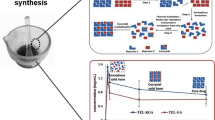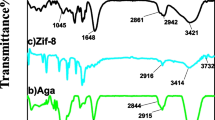Abstract
Purpose
The study aims to develop an interpenetrating polymer network (IPN) hydrogel bead. This drug carrier system with a hydrophilic polymer is designed through an ionotropic gelation technique using divalent calcium ions as a crosslinking agent. The resultant polymeric composite extends the release of the short-acting oral sulfonylurea drug, glipizide.
Methods
The IPN hydrogel beads prepared with more than one polymer bring forth better mechanical strength in contrast to a single polymeric-based network hydrogel system. This hydrogel bead of hydrophilic sodium alginate (SAL), the concentration of which ranges from 1.5 to 2.0% w/w, and xanthan gum (XAG) polymer, whose concentration ranges between 0.5 and 1.0% w/w, has been prepared to control the drug release profile. An ionotropic gelation technique with the crosslinking agent, calcium chloride at 2.5–7.5% w/w concentration, was adopted to prepare the IPN hydrogel bead drug carrier.
Results
The prepared hydrogel bead was studied for viscosity analysis of prepared composite dispersion, particle size, drug entrapment, swelling functions, and in vitro drug dissolution. An increase in xanthan gum quantity levels resulted in increased viscosity of prepared composite dispersions and hence the increased mean diameter of produced IPN hydrogel beads. Increased crosslinker concentration showed a slightly smaller IPN hydrogel bead mean diameter and increased encapsulation of loaded drug to about 88 to 91% glipizide. The in vitro drug dissolution was observed to be slower with increased xanthan gum polymer and calcium ion crosslinker concentration, which extended the drug release to 14 h. Thus, this work demonstrates that the XAG and calcium ion crosslinkers play a significant role in controlling the release of the loaded drug, glipizide.
Conclusion
Based on the results obtained, it can be concluded that the prepared novel polymeric-based IPN drug carrier system has beneficially controlled the drug release of short-acting oral sulphonyl medication and acted as an extended drug release system.




Similar content being viewed by others
Data Availability
Data included in article/supplementary material/referenced in article.
Abbreviations
- IPN:
-
Interpenetrating polymer network
- SAL:
-
Sodium alginate
- XAG:
-
Xanthan gum
- AL-XAG:
-
Alginate-xanthan gum
- GLI:
-
Glipizide
- GCA-XAG:
-
Glipizide-loaded calcium alginate-xanthan gum bead
- UV-Vis:
-
UV-visible spectrophotometer
- ANOVA:
-
Analysis of variance
- AIC:
-
Akaike information criterion
References
Barbani N, Cascone MG, Giusti P, Lazzeri L, Polacco G, Pizziarani G. Bio artificial materials based on collagen: mixtures of soluble collagen and poly(vinylalcohol) cross-linked with gaseous glutaraldehyde. J Biomater Sci Polym Ed. 1995. https://doi.org/10.1163/156856295x00544.
Cascone MG. Dynamic - mechanical properties of bio artificial polymeric materials. Polym Int. 1997. https://doi.org/10.1002/(SICI)1097-0126(199705)43:1%3C55::AID-PI762%3E3.0.CO;2-%23.
Sperling L, Hu R. Interpenetrating polymer networks. In: Utracki LA, Wilkie C, editors. Polymer Blends Handbook. 2nd ed. Dordrecht: Springer; 2014. p. 677–724.
Raina N, Rani R, Khan A, Nagpal K, Gupta M. Interpenetrating polymer network as a pioneer drug delivery system: a review. Polym Bull. 2020;5027–50. https://doi.org/10.1007/s00289-019-02996-5.
Biswas A, Mondal S, Das SK, Bose A, Thomas S, Ghosal K, Roy S, Provaznik I. Development and characterization of natural product derived macromolecules based interpenetrating polymer network for therapeutic drug targeting. ACS Omega. 2021;28699–709. https://doi.org/10.1021/acsomega.1c03363.
Santos LA. Natural polymeric biomaterials: processing and properties. Reference module in materials science and materials engineering; Elsevier: Amsterdam, The Netherlands. 2017. https://doi.org/10.1016/B978-0-12-803581-8.02253-0.
Desai NP, Sojomihardjo A, Yao Z, Ron N, Soon-Shiong P. Interpenetrating polymer networks of alginate and polyethylene glycol for encapsulation of islets of Langerhans. J Microencapsul. 2000. https://doi.org/10.1080/02652040050161675.
Singhvi G, Hans N, Shiva N, Dubey SK. Xanthan gum in drug delivery applications. InNatural polysaccharides in drug delivery and biomedical applications. Academic Press. 2019. https://doi.org/10.1016/B978-0-12-817055-7.00005-4.
Mandal S, Basu SK, Sa B. Ca2+ ion cross-linked interpenetrating network matrix tablets of polyacrylamide-grafted-sodium alginate and sodium alginate for sustained release of diltiazem hydrochloride. Carbohydr Polym. 2010. https://doi.org/10.1016/j.carbpol.2010.06.009.
Kubo W, Miyazaki S, Attwood D. Oral sustained delivery of paracetamol from in situ-gelling gellan and sodium alginate formulations. Int J Pharm. 2003. https://doi.org/10.1016/S0378-5173(03)00163-7.
Saadatlou GA, Pircheraghi G. Concentrated regimes of xanthan-based hydrogels crosslinked with multifunctional crosslinkers. Carbohydr Polym Technol Appl. 2021. https://doi.org/10.1016/j.carpta.2021.100047.
Calo E, Khutoryanskiy VV. Biomedical applications of hydrogels: a review of patents and commercial products. Eur Polym J. 2015. https://doi.org/10.1016/j.eurpolymj.2014.11.024.
Tao Y, Zhang R, Xu W, Bai Z, Zhou Y, Zhao S, Xu Y, Yu D. Rheological behavior and microstructure of release-controlled hydrogels based on xanthan gum crosslinked with sodium trimetaphosphate. Food Hydrocoll. 2016. https://doi.org/10.1016/J.FOODHYD.2015.09.006.
Ray S, Banerjee S, Maiti S, Laha B, Barik S, Sa B, Bhattacharyya UK. Novel interpenetrating network microspheres of xanthan gum–poly (vinyl alcohol) for the delivery of diclofenac sodium to the intestine-in vitro and in vivo evaluation. Drug Delivery. 2010. https://doi.org/10.3109/10717544.2010.483256.
Alupei IC, Popa M, Hamcerencu M, Abadie MJ. Superabsorbant hydrogels based on xanthan and poly (vinyl alcohol): 1. The study of the swelling properties. Eur Polym J. 2002. https://doi.org/10.1016/S0014-3057(02)00106-4.
Sellamuthu K, Angappan S. Design, development and characterization of interpenetrating polymer network hydrogel bead for controlled release of glipizide drug. Drug Dev Ind Pharm. 2022. https://doi.org/10.1080/03639045.2022.2130939.
Chowdary KPR, Srinivasa YR. Design and in vitro evaluation of mucoadhesive controlled release oral tablet of glipizide. Indian J Pharm. 2003. https://doi.org/10.1208/pt040339.
Verma RK, Garg S. Development and evaluation of osmotically controlled oral delivery system of glipizide. Eur J Pharm Biopharm. 2004. https://doi.org/10.1016/j.ejpb.2004.02.003.
Harlay CR. Glipizide GRTS has advantages over other second generation sulfonylurea. Clin Drug Invest. 2002.
Patel JK, Patel RP, Amin AF, Patel MM. Formulation and evaluation of mucoadhesive glipizide microspheres. AAPS Pharm Sci Tech. 2005. https://doi.org/10.1208/pt060110.
Hesieh SH, Lin JD, Chang HY, Ho Ch, Liou MJ. Sustained release versus immediate release glipizide for the treatment of diabetes mellitus in Chinese patients: a randomized, double blind, double dummy, parallel group, 12 week clinical study. ClinTher. 2006. https://doi.org/10.1016/j.clinthera.2006.09.010.
Dey S. Pramanik S, Malgope A. Formulation and optimization of sustained release stavudine microspheres using response surface methodology. Int Sci Res Notices. 2011. https://doi.org/10.5402%2F2011%2F627623.
Kulkarni RV, Sa B. Polyacrylamide-grafted-alginate-based pH-sensitive hydrogel beads for delivery of ketoprofen to the intestine: in vitro and in vivo evaluation. J Biomater Sci Polym Ed. 2009. https://doi.org/10.1163/156856209x404514.
Zhang Y, Liu J, Huang L, Wang Z, Wang L. Design and performance of a sericin-alginate interpenetrating network hydrogel for cell and drug delivery. Sci Rep. 2015. https://doi.org/10.1038/srep12374.
Bhattarai N, Ramay HR, Gunn J, Frederick AM, Zhang M. PEG-grafted chitosan as an injectable thermosensitive hydrogel for sustained protein release. J Control Release. 2005. https://doi.org/10.1016/j.jconrel.2004.12.019.
Dubey S, Bajpai SK. Poly(methacrylamide-co-acrylic acid)hydrogels for gastrointestinal delivery of theophylline. I. Swelling characterization. J Appl Polym Sci. 2006. https://doi.org/10.1002/app.23542.
Philips GO, Williams PA. Handbook of hydrocolloids. 2nd ed. New York: Woodhead Publishing Limited; 2009. p. 118–202.
Goddard ED, Gruber JV. Principles of polymer science and technology in cosmetics and personal care. Marcel Dekkner Inc.: New York: Basel; 1999.
Gruber JV, Konish PN. Building aqueous viscosity through synergistic polymer–polymer interactions. ACS Symposium Series. 1999. pp. 252–261.
Pongjanyakul T, Puttipipatkhachorn S. Xanthan–alginate composite gel beads: molecular interaction and in vitro characterization. Int J Pharm. 2007. https://doi.org/10.1016/j.ijpharm.2006.09.011.
Nafo W. Hydrogel biomaterials for drug delivery: mechanisms, design, and drugs in hydrogels - from tradition to innovative platforms with multiple applications. South Korea Intechopen. 2022. https://doi.org/10.5772/intechopen.103156.
Gazori T, Khoshayand MR, Azizi E, Yazdizade P. Evaluation of alginate/chitosan nanoparticles as antisense delivery vector: formulation, optimization and in vitro characterization. Carbohyd Polym. 2009. https://doi.org/10.1016/j.carbpol.2009.02.019.
Ray R, Maity S, Mandal S, Chatterjee TK, Sa B. Development and evaluation of a new interpenetrating network bead of sodium carboxymethyl xanthan and sodium alginate. Pharmacology & Pharmacy. 2010. https://doi.org/10.4236/pp.2010.11002.
Kankala R.K, Wang S, Chen A, Zhang Y.S. Handbook of nanomaterials for cancer theranostics. Chapter 2 - Self-assembled nanogels: from particles to scaffolds and membranes. Elsevier. 2018. https://doi.org/10.1016/B978-0-12-813339-2.00002-5.
Hoffman AS. Hydrogels for biomedical applications. Adv Drug Deliv Rev. 2002. pp. 3–12. https://doi.org/10.1016/j.addr.2012.09.010.
Pasparakis G, Bouropoulos N. Swelling studies and in vitro release of verapamil from calcium alginate and calcium alginate-chitosan beads. Int J Pharm. 2006. https://doi.org/10.1016/j.ijpharm.2006.05.054.
Chen J, Liu M, Chen S. Synthesis and characterization of thermo- and pH-sensitive kappa-carrageenan-g-poly(methacrylic acid)/poly(N, N-diethylacrylamide) semi-IPN hydrogel. Mater Chem Phys. 2009. https://doi.org/10.1016/j.matchemphys.2008.12.026.
Sugawara S, Imai T, Otagiri M. The controlled release of prednisolone using alginate gel. Pharm Res. 1994. https://doi.org/10.1023/a:1018963626248.
Dainty AL, Goulding KH, Robinson PK, Simpkins I, Trevan MD. Stability of alginate-immobilized algal cells. Biotechnol Bioeng. 1986. https://doi.org/10.1002/bit.260280210.
Kikuchi K, Kawabuchi M, Sugihara M, Sakurai Y, Okano T. Pulsed dextran release from calcium-alginate gel beads. J Control Release. 1997. https://doi.org/10.1016/S0168-3659(96)01612-4.
Dash S, Murthy PN, Nath L, Chowdhury P. Kinetic modeling on drug release from controlled drug delivery systems. Acta Pol Pharm. 2010.
Paarakh MP, Jose PA, Setty CM, Christoper GVP. Release kinetics-concepts and applications. Int J Pharm res technol. 2018. https://doi.org/10.31838/ijprt/08.01.02.
Costa P, Lobo JMS. Modeling and comparison of dissolution profiles. Eur J Pharm Sci. 2001. https://doi.org/10.1016/s0928-0987(01)00095-1.
Acknowledgements
The authors are thankful to the Vellore Institute of Technology, Vellore, management for their assistance throughout the aspects of our current study of work. The authors also express their sincere gratitude to School of Advanced Sciences, Vellore Institute of Technology, Vellore, for their exceptional support and encouragement.
Author information
Authors and Affiliations
Corresponding author
Ethics declarations
Competing Interests
The authors declare no competing interests.
Additional information
Publisher's Note
Springer Nature remains neutral with regard to jurisdictional claims in published maps and institutional affiliations.
Rights and permissions
Springer Nature or its licensor (e.g. a society or other partner) holds exclusive rights to this article under a publishing agreement with the author(s) or other rightsholder(s); author self-archiving of the accepted manuscript version of this article is solely governed by the terms of such publishing agreement and applicable law.
About this article
Cite this article
Sellamuthu, K., Angappan, S. Formulation and Characterization of Interpenetrating Polymer Network Hydrogel Bead as Drug Carrier System for Extended Release of Sulphonyl Urea Medication. J Pharm Innov 19, 2 (2024). https://doi.org/10.1007/s12247-024-09811-3
Accepted:
Published:
DOI: https://doi.org/10.1007/s12247-024-09811-3




